Your Guide to the Captain Cook Snorkel Tour
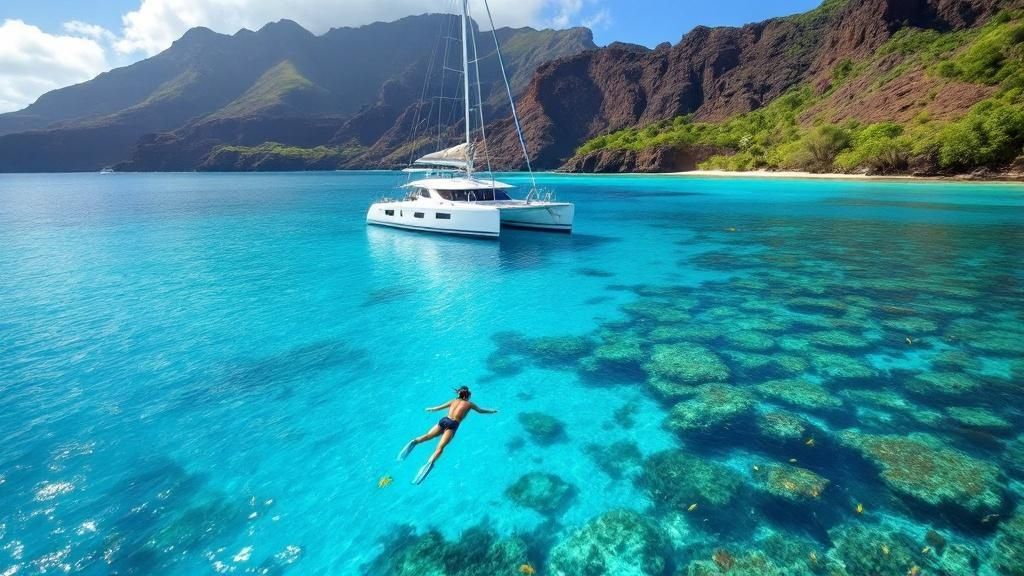
Picture this: you're gliding through calm, crystal-clear water, floating above a coral reef bursting with color. Below you is a world-class marine sanctuary, and along the shoreline, ancient cliffs tell stories of Hawaiian history. This is the Captain Cook snorkel tour, and it's a legendary Big Island adventure for a good reason. It perfectly blends incredible snorkeling with a trip back in time to one of Hawaii's most important historical sites.
Why This Snorkel Tour Is A Legendary Experience
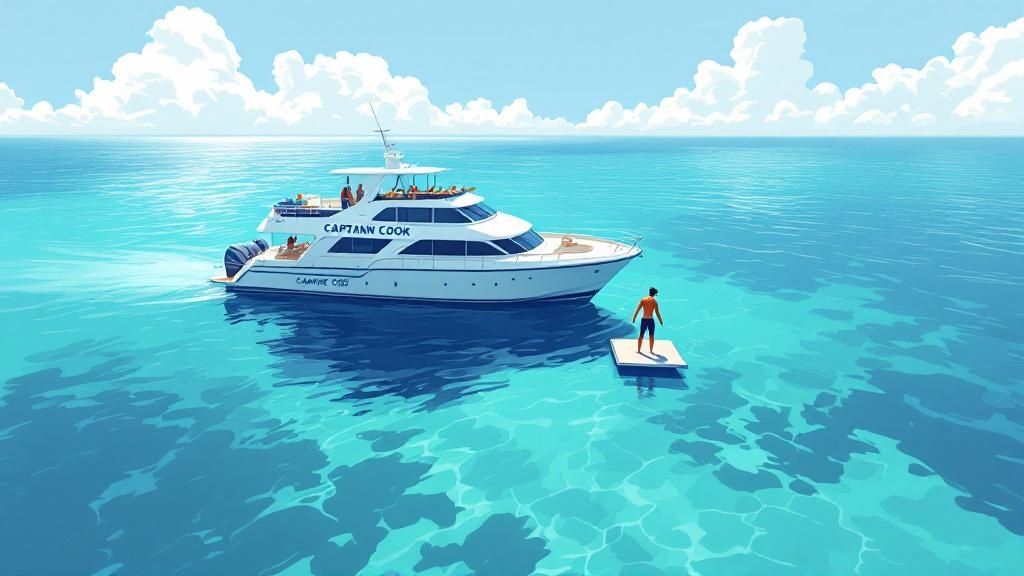
A Captain Cook snorkel tour is so much more than just a boat ride; it’s like stepping into a living story. The destination, Kealakekua Bay, is where two powerful narratives meet. Under the surface, you have a jaw-dropping aquatic world. Above it, the rugged coastline holds the history of Captain James Cook’s arrival and his fateful final days.
This double-shot of magic is what truly sets the experience apart. One minute, you’re completely mesmerized by a school of bright yellow tangs weaving through the coral. The next, you’re looking at the white obelisk of the Captain Cook Monument, thinking about a pivotal moment in world history. It’s this unique mix that makes it a must-do for nature lovers and history buffs alike.
A Sanctuary For Marine Life
Kealakekua Bay isn’t just a pretty face—it's a legally protected Marine Life Conservation District (MLCD). You can think of it as an underwater national park. Because of this special status, the bay’s ecosystem is exceptionally healthy and packed with life.
The calm, sheltered waters are the perfect nursery for coral to thrive, which in turn supports a stunning diversity of fish and other sea creatures. You're not just taking a dip in the ocean; you're visiting a vibrant, pristine underwater community.
Here’s a quick look at what makes this tour so special:
| Feature | Description |
|---|---|
| Location | Kealakekua Bay, a protected Marine Life Conservation District. |
| Highlights | World-class snorkeling, exceptional water clarity, and rich historical significance. |
| Marine Life | Healthy coral reefs, hundreds of species of tropical fish, and frequent spinner dolphin sightings. |
| Historical Site | The Captain Cook Monument, marking a key point of contact between Western and Hawaiian cultures. |
| Accessibility | Best reached by boat tour, as land access is very difficult. |
This combination of features makes the Captain Cook snorkel tour a truly well-rounded and unforgettable adventure.
The bay’s dual appeal is undeniable. It attracts over 190,000 visitors annually, making it one of Hawaii's most frequented snorkeling destinations. This popularity is rooted in both its vibrant marine ecosystem and its deep cultural significance as Captain Cook's 1779 landing site. Learn more about the history and draw of this location from Kona Snorkel Trips.
This protected status is also why the underwater visibility is often incredible, letting you see every little detail of the reef with amazing clarity. You really get a front-row seat to one of the most vibrant marine environments in all of Hawaii. For a deeper dive, check out our comprehensive guide on Captain Cook snorkeling to see what you might encounter.
A Journey Through Time
The historical weight of Kealakekua Bay adds a really profound layer to the whole adventure. This is the spot where Western and native Hawaiian cultures had their first major, sustained contact. The bay is a living museum, and the tour is your time machine.
- Cultural Significance: The guides on these tours are fantastic storytellers, sharing legends and history that turn the beautiful scenery into a rich cultural landscape.
- The Monument: That iconic white monument stands on a small piece of land that was actually deeded to the United Kingdom. It marks where Cook was killed and serves as a powerful reminder of the complex history that played out right here.
It’s this fusion of raw natural beauty and deep historical importance that makes the Captain Cook snorkel tour a journey you won’t soon forget.
How to Choose the Right Snorkel Tour Operator
Picking the right company for your Captain Cook snorkel tour is a lot like choosing your ride for a safari. Are you looking for a nimble, open-air jeep to get right into the action, or a more comfortable, spacious tour bus with all the bells and whistles? The boat you choose—and the crew running it—will shape your entire day in Kealakekua Bay.
The first thing to consider is the boat itself. Big, stable catamarans are fantastic for families or anyone who puts a premium on comfort. They often come loaded with amenities like onboard restrooms, plenty of shade, and sometimes even water slides. It’s a relaxed, easygoing way to spend a day on the water.
If you’re craving a bit more thrill, you might lean towards the smaller, rigid-hulled inflatable boats, which most people just call Zodiacs. These boats are fast and exciting, zipping you out to the snorkel spot in no time. Their smaller size often means they can poke into sea caves and lava tubes that the bigger boats have to pass by. The trade-off? A bumpier ride and fewer creature comforts, for sure.
Vetting Your Tour Company
Once you have an idea of the kind of boat you’d prefer, it's time to dig into the companies themselves. They are definitely not all the same, and a few key details can make a world of difference for your trip’s quality and safety. Don't just get tempted by the lowest price; you have to look at what you’re actually getting for your money.
A great tour is so much more than just a taxi to a snorkel spot. It's an entire experience curated from start to finish. The best operators I've seen seamlessly blend top-notch safety, real education, and that genuine spirit of aloha to create a day you'll never forget. They get that they're caretakers of both the fragile marine ecosystem and Hawaiian culture.
Here’s what you should be looking for:
- Safety Record and Certifications: Look for companies that are proud of their safety protocols. Are their guides lifeguard certified? Do they have a long-standing, positive reputation in the local community? This is non-negotiable.
- Guide Expertise: A passionate, knowledgeable guide can completely transform your trip. The best ones aren't just skilled boat captains; they’re storytellers who can share fascinating tidbits about marine biology, local history, and Hawaiian culture.
- Gear Quality: There’s nothing worse than a leaky, worn-out snorkel mask to ruin a perfectly good day. Good companies invest in high-quality, well-maintained gear. This includes flotation devices for snorkelers of all skill levels.
- Group Size: I'll always argue that smaller groups make for a better, more personal experience. You get more one-on-one attention from the guides and won't feel like you're just another face in the crowd, especially in the water.
This decision tree is a pretty handy tool for figuring out which tour best matches what you’re looking for in terms of experience, visibility, and the density of marine life.
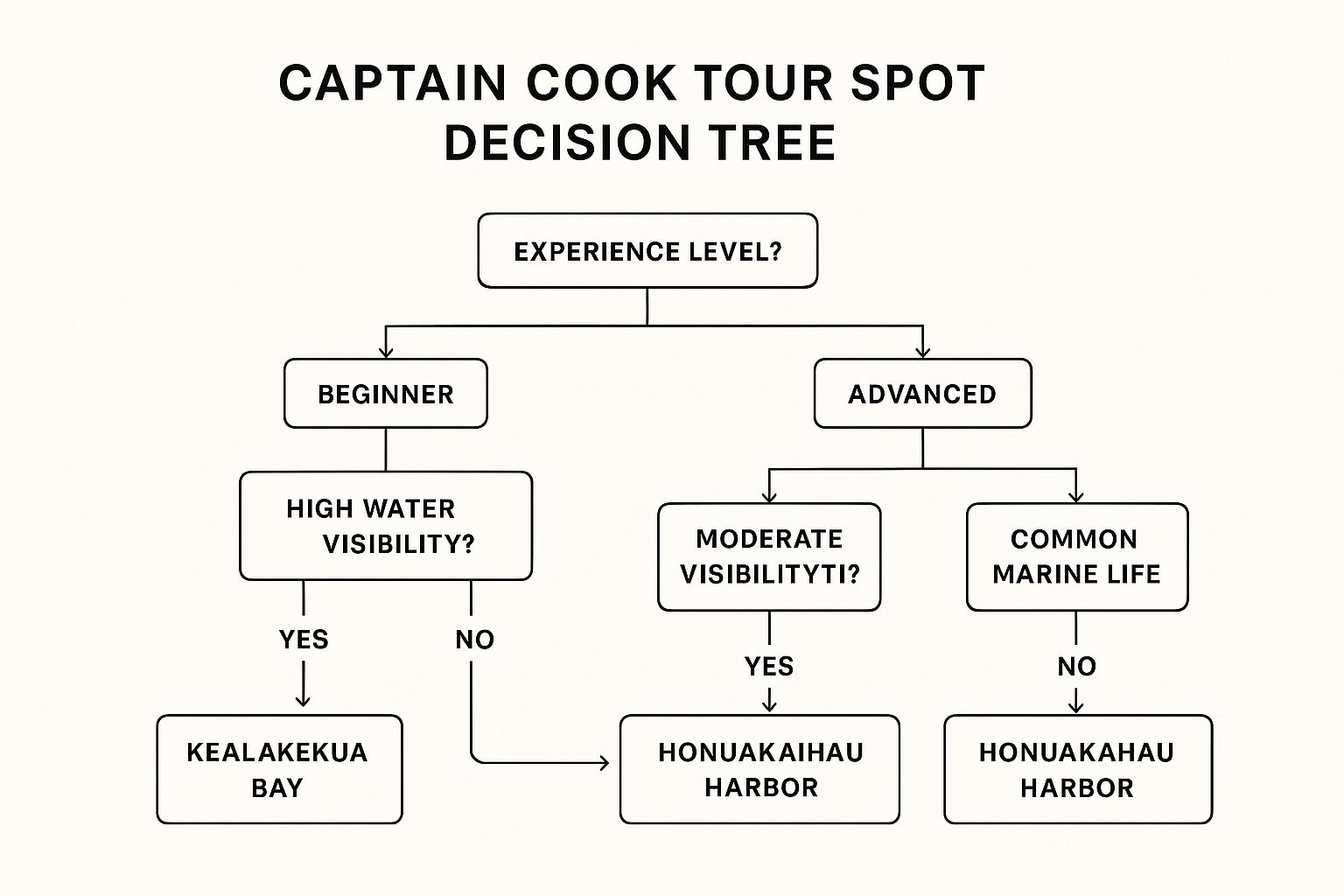
As you can see from the infographic, different priorities will point you toward different snorkeling locations, helping you align your personal wish list with a specific tour's focus.
Comparing Value and Inclusions
Finally, you need to weigh the overall value. Does the tour price cover lunch, snacks, and drinks? Are there sneaky fees for gear or fuel that pop up later? Some tours might look cheaper on the surface but can end up costing you more when all is said and done.
Taking a moment to compare different Big Island snorkeling tours will give you a much clearer picture of what a fair price actually gets you. Ultimately, it’s all about finding that sweet spot—the operator that perfectly aligns with your budget, your comfort level, and your sense of adventure.
What to Expect on Your Kealakekua Bay Adventure
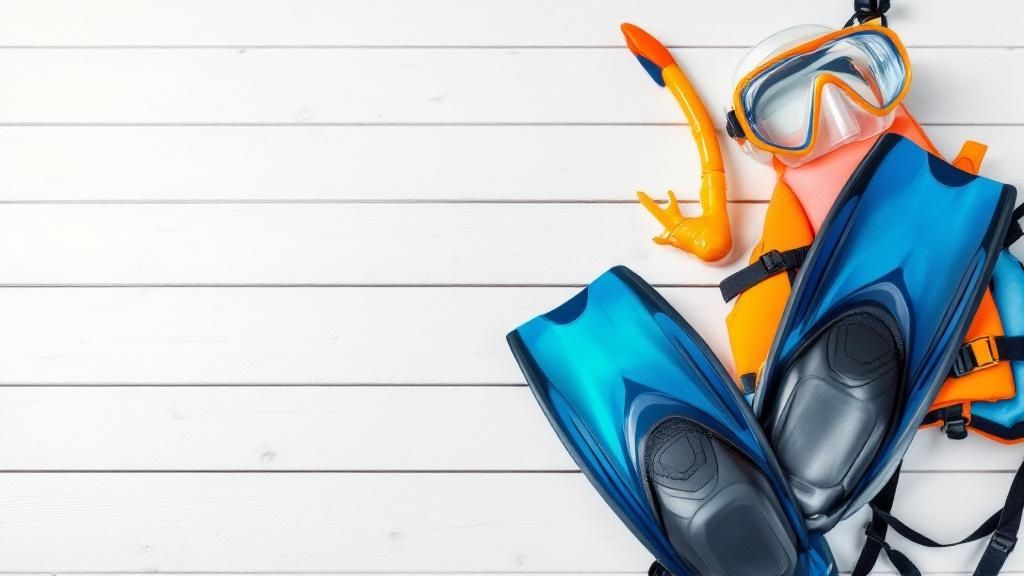
Trust me, the adventure starts long before you ever get your snorkel mask wet. The boat ride out to Kealakekua Bay is an experience all on its own, giving you a view of the Kona coast you just can't get from the shore. As you leave the harbor, you'll cruise past a dramatic coastline carved from ancient lava flows.
Keep your eyes peeled. The journey over often turns into an impromptu wildlife tour. It’s pretty common to see pods of playful spinner dolphins showing off, racing the boat and launching themselves into the air. If you're here in the winter (December through March), you might get the truly unforgettable sight of a humpback whale breaching the surface.
Arriving at an Underwater Paradise
The real magic kicks in when the boat glides into the calm waters of Kealakekua Bay. The engines quiet down, and you’re suddenly surrounded by steep, green cliffs and the famous white obelisk of the Captain Cook Monument. The water here is famously clear, giving you a little sneak peek of the colorful world just waiting below.
This is where your crew will run through a quick safety talk and get you fitted with good-quality snorkel gear. They’ll share some pro tips to make sure everyone, especially first-timers, feels comfortable and ready to jump in.
A typical tour in Kealakekua Bay puts you face-to-face with around 50 different marine species, all in water that’s about 20 feet deep. The bay is a protected Marine Life Conservation District, which is why the ecosystem is so healthy and the water stays so clear. You can dig into more of what makes these trips so special by checking out these insights on Captain Cook snorkeling tours.
Your Snorkeling Experience
The moment you slide into that warm, calm water, you’ll get it. You'll see exactly why this place is world-famous. It really is like floating in a giant, thriving aquarium. You can expect to see:
- Schools of Vibrant Fish: Get ready for clouds of bright yellow tang, black-and-white striped convict tang, and rainbow-colored parrotfish. They’re everywhere.
- Unique Hawaiian Species: Keep an eye out for the humuhumunukunukuāpuaʻa—Hawaii's state fish—as it darts around the coral.
- Honu (Green Sea Turtles): It's always a treat to see Hawaiian green sea turtles gliding gracefully through the bay or just chilling on the ocean floor.
The conditions in Kealakekua Bay are usually super gentle, which makes it perfect for snorkelers of any skill level. The visibility can easily top 100 feet, giving you crystal-clear views of the healthy coral gardens and all the marine life that calls this sanctuary home. Your time in the water is the absolute highlight of the Captain Cook snorkel tour—a truly immersive experience you won't forget.
Your Essential Packing and Preparation Checklist
A little bit of planning before your Captain Cook snorkel tour can be the difference between a pretty good day and an absolutely perfect one. If you think ahead just a little, you'll be comfortable, protected, and ready to focus on what you came for: the incredible underwater world of Kealakekua Bay.
Sun protection has to be at the top of your list. The Hawaiian sun is no joke, especially when it’s bouncing right off the water. Make sure to pack a high-quality, reef-safe sunscreen—this protects both your skin and the fragile coral reef you're about to visit. A good hat and a pair of polarized sunglasses are also clutch for cutting the glare and saving your eyes.
What to Wear for a Day on the Water
Comfort is everything when you're out on the boat. The easiest thing to do is wear your swimsuit under your clothes so you’re ready to hop in the second you get there.
For your top layer, think light and quick-drying. A rash guard or a simple cover-up is perfect. They don't just add another layer of sun protection; they also keep you from getting chilled on the boat ride back. Most people go barefoot on the boat for safety, but you’ll want some flip-flops or water shoes for the walk to and from the dock.
Snorkel Gear: Bring Your Own or Use Theirs?
This is a question we get all the time, and it really comes down to personal preference. The tour operators provide good, sanitized gear that's perfectly fine for most people. It's convenient, and you don't have to lug your own stuff all the way to Hawaii.
That said, if you have a high-quality mask that you know fits your face perfectly, bring it. A mask that creates a perfect seal is a game-changer. It means no annoying leaks, no stopping to clear water, and a much, much better snorkeling experience. Fins are usually big and bulky, so I'd recommend just using the ones the tour provides.
A well-fitting mask is like having a perfectly clear window into another world. If you've ever struggled with a leaky rental, you know how distracting it can be. Bringing your own trusted mask ensures you spend less time adjusting and more time marveling at the fish.
Don't Leave Home Without These
A few extra items can take your day from great to unforgettable. Here’s a quick list of things to toss in your day bag:
- Waterproof Camera or Phone Case: You are absolutely going to want to capture photos of the fish and coral. An action camera like a GoPro or even a simple waterproof phone pouch is a must.
- Towel: Most tours don't hand out towels, so definitely bring your own for drying off after your swim.
- Seasickness Medication: If you even think you might get motion sickness, take something before you get on the boat. The ride can get a little bumpy, and it's always better to be prepared.
- Reusable Water Bottle: Staying hydrated out on the water is crucial. While tours offer drinks, bringing your own bottle is a smart and eco-friendly move.
Pack these things, and you'll be all set for an incredible and comfortable day on your Captain Cook snorkel tour.
How to Snorkel Respectfully and Protect the Reef
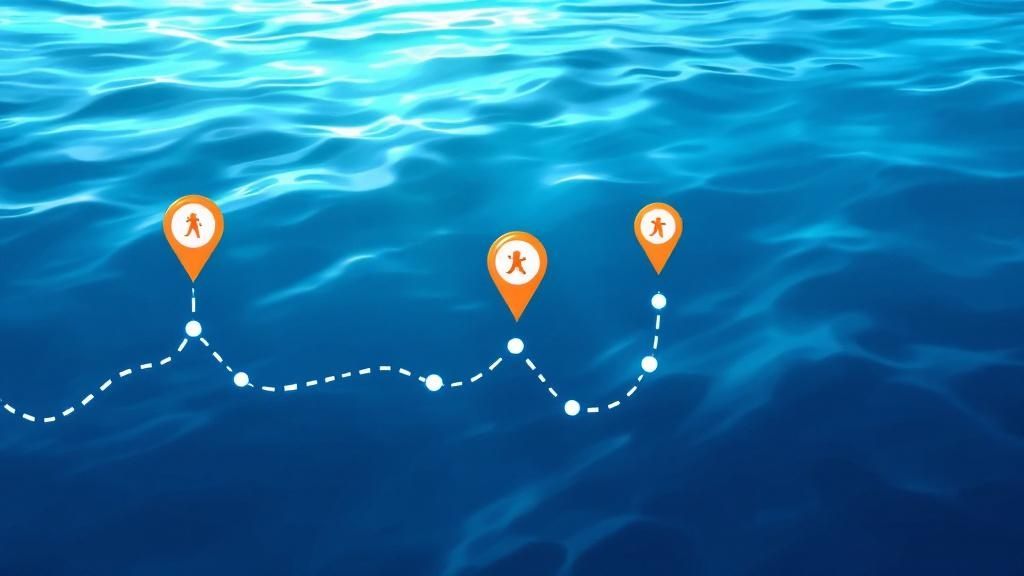
Heading out on a Captain Cook snorkel tour is so much more than just a fun day on the water. It’s an invitation into a fragile and truly sacred space. Here in Hawaii, the idea of mālama i ka ʻāina—caring for the land and sea—is a core part of the culture. As a visitor, you have a special role to play as a guardian of this underwater paradise.
Your actions, no matter how small they feel, add up. They have a direct impact on the health of Kealakekua Bay's incredible ecosystem. It helps to think of the coral reef as a living, breathing city full of delicate structures. Just like you wouldn't walk on someone's roof, you must never, ever touch, stand on, or kick the coral. These are living animals, and they're incredibly sensitive. The slightest bump can cause damage that takes years to heal, or even kill them outright.
The Golden Rules of Reef Etiquette
Keeping the reef vibrant for future generations is actually pretty simple. If you follow these essential guidelines, you'll be showing the utmost respect for the underwater world and the local culture that cherishes it.
- Admire from a Distance: Keep a respectful distance from all marine life, including sea turtles (honu) and dolphins (naiʻa). Never chase them or try to touch them. Doing so causes a lot of stress and messes with their natural routines.
- Use Reef-Safe Sunscreen: This one is huge. Standard sunscreens have chemicals like oxybenzone and octinoxate that are basically poison to coral, causing them to bleach and die. Always, always opt for a mineral-based sunscreen with non-nano zinc oxide or titanium dioxide.
- Leave No Trace: Take only pictures, leave only bubbles. Nothing should ever be taken from the bay—not a tiny shell, not a piece of coral. And of course, make sure every bit of your trash makes it back to the boat with you.
To snorkel respectfully is to be a silent, observant guest in another world. Your goal is to leave the environment exactly as you found it, ensuring its magic remains for all who follow. This principle of minimal impact is the core of responsible tourism.
If you want to dive deeper into this mindset, a good sustainable boating guide can offer even more ways to promote eco-friendly adventures on the water.
Respecting the Captain Cook Monument
That white obelisk you see on the shoreline isn't just a photo op; it's a historical monument and a gravesite. Your tour will get you close, but it’s crucial to remember this is a place with deep historical weight. Pay close attention to your guide’s instructions about proper etiquette, which will mean observing it respectfully from the boat or the water.
Your mindfulness on a Captain Cook snorkel tour is what helps preserve this amazing natural and historical treasure. By snorkeling with care, you're helping protect the very beauty you came all this way to see.
Of course. Here is the rewritten section, crafted to sound like it was written by an experienced human expert, following all the specified requirements.
Answering Your Captain Cook Snorkel Tour Questions
You've got your trip planned, but a few questions are probably rattling around in your head. That's completely normal. Let's tackle some of the most common ones we hear about the Captain Cook snorkel tour. Getting these details sorted will let you book your trip with confidence, knowing exactly what to expect.
A big one we get, especially from first-timers, is about swimming skills. It’s a totally fair question, but let me put your mind at ease. You absolutely do not need to be a strong swimmer to have an amazing time.
Every good tour company will have plenty of high-quality flotation gear, like pool noodles and snorkel vests. These things are fantastic—they let you just bob on the surface and focus all your attention on the stunning coral and fish below, without giving a second thought to staying afloat. Plus, the guides are always lifeguard-certified and right there in the water with you, ready to help out and keep everyone safe.
Is This Tour Good for Beginners and Non-Swimmers?
Yes, one hundred percent. The waters in Kealakekua Bay are famously calm and protected, almost like a massive, natural swimming pool. This makes it an incredibly forgiving place to learn or just get comfortable in the water.
When you combine those calm conditions with flotation devices and an expert crew watching over you, it creates a super safe and welcoming environment for absolutely everyone. You don't have to be Michael Phelps to enjoy one of the world's best snorkel spots. The crew's main job is to make sure you feel safe and have a blast.
A great guide does more than point out fish; they build confidence. They can turn a nervous first-timer into a relaxed snorkeler in minutes, simply by offering patient instruction and ensuring they feel secure in the water.
This kind of personalized support is what really separates a quality Captain Cook snorkel tour from the rest.
What Is the Best Time of Year to Go?
Truthfully, the Big Island offers incredible snorkeling all year long. The water stays warm and clear, but there are some seasonal differences worth knowing about.
For the absolute best conditions, aim for the drier season, from April to October. This is when you'll usually get the sunniest days and the calmest seas. It makes for a gorgeous boat ride and truly spectacular visibility underwater.
That said, the winter months (December through March) have a pretty spectacular trick up their sleeve: it's whale season. Humpback whales migrate here to breed and have their babies, and seeing them breach on the way to and from the bay is an experience you will never, ever forget. It adds a whole other layer of magic to the tour. You can get a better sense of the whole journey in our complete Captain Cook snorkel tour guide.
Can I Just Hike or Kayak to the Monument Myself?
We hear this question a lot. While it's technically possible to get to the Captain Cook Monument on your own, it's a massive undertaking and something we really don't recommend for most visitors. There are some serious obstacles to consider.
- The Hike: The trail leading down to the bay is a beast. It's a 3.8-mile round trip with a tough 1,300-foot elevation change. The path itself is rocky, completely exposed to the sun, and the hike back up can be brutally hot and exhausting.
- Kayaking Permits: To protect the bay's delicate ecosystem, you can't just rent a kayak and paddle over. You need a specific permit to land a kayak at Kaʻawaloa (the monument area), and these are only available through three licensed commercial vendors.
- No Facilities: Once you're down there, you are completely on your own. There's no drinking water, no restrooms, and virtually no shade. You have to pack in everything you need—and, more importantly, pack every single thing back out.
For all these reasons, taking a boat tour is, without a doubt, the best way to experience this historic spot. It transforms what would be a logistical nightmare into a comfortable, relaxing, and educational day on the water. You get to focus on the beauty and history of Kealakekua Bay without the physical punishment.
Ready for an unforgettable adventure? Kona Snorkel Trips offers Hawaii's highest-rated and most-reviewed tours to Kealakekua Bay, with lifeguard-certified guides and a commitment to small-group experiences. Book your adventure today at https://www.konasnorkeltrips.com.
